NRSG370 Assignment 2: Perioperative Safety Incident Analysis
VerifiedAdded on 2022/12/30
|6
|1612
|71
Essay
AI Summary
This essay critically analyzes a clinical incident related to perioperative nursing, specifically addressing a medication error where a nurse administered a different medicine due to a shortage, leading to allergic reactions in the patient. The analysis delves into the safety issues arising from this incident, including potential delays in surgery, patient distrust, and adverse health impacts. The essay identifies the root cause as a lack of proper medication facilities and explores broader safety concerns such as the use of uncleaned syringes and excessive drug dosages. Furthermore, it examines relevant codes, ethics, and policies that could mitigate such errors, including the use of web-based forms for error detection and adherence to ethical guidelines like the Dartmouth-Hitchcock Medical Center Code of Professional Conduct and the Sentinel Event Policy. The conclusion emphasizes the importance of implementing these measures to reduce errors, enhance patient safety, and improve the overall quality of perioperative care, supported by references to relevant research.
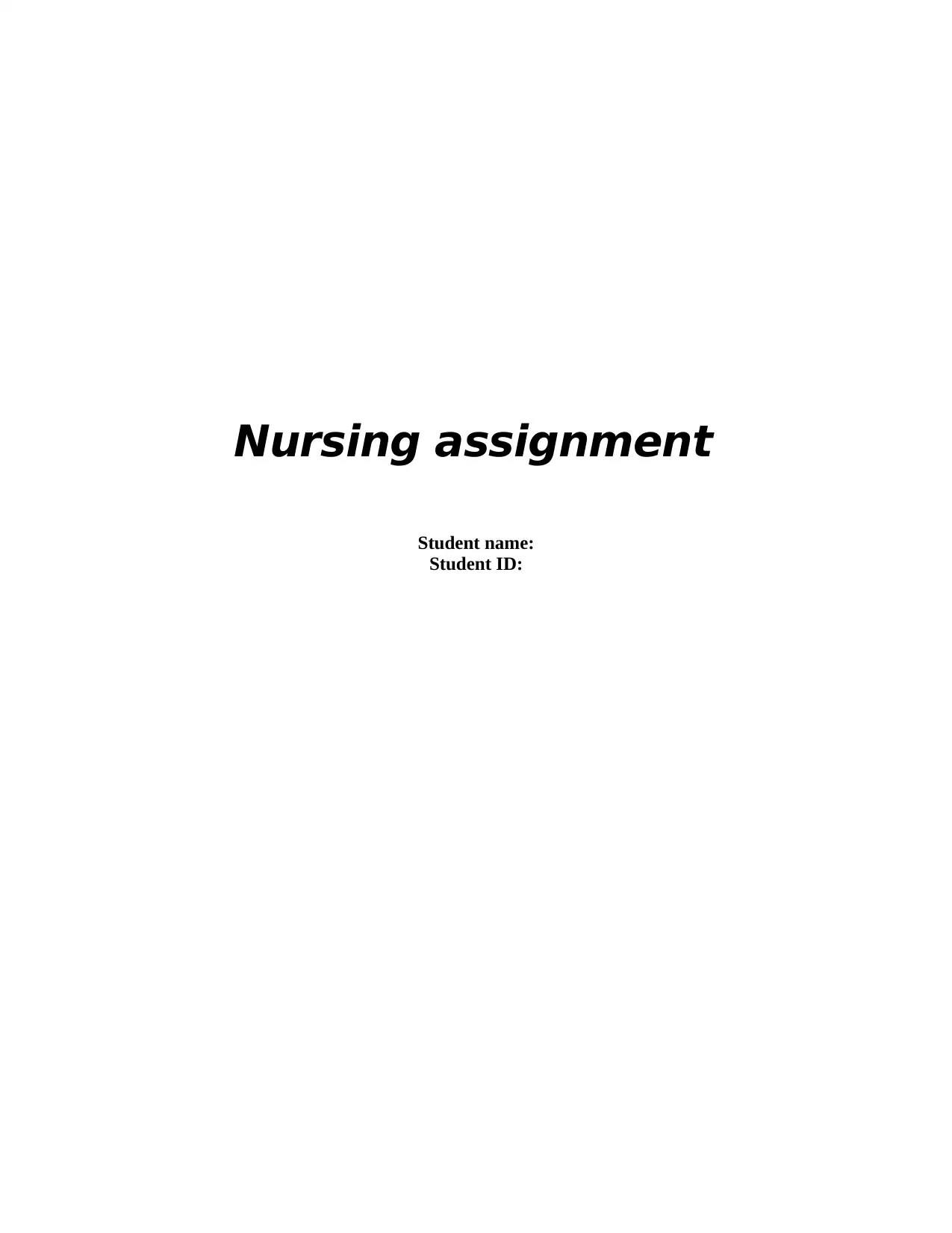
Nursing assignment
Student name:
Student ID:
Student name:
Student ID:
Paraphrase This Document
Need a fresh take? Get an instant paraphrase of this document with our AI Paraphraser
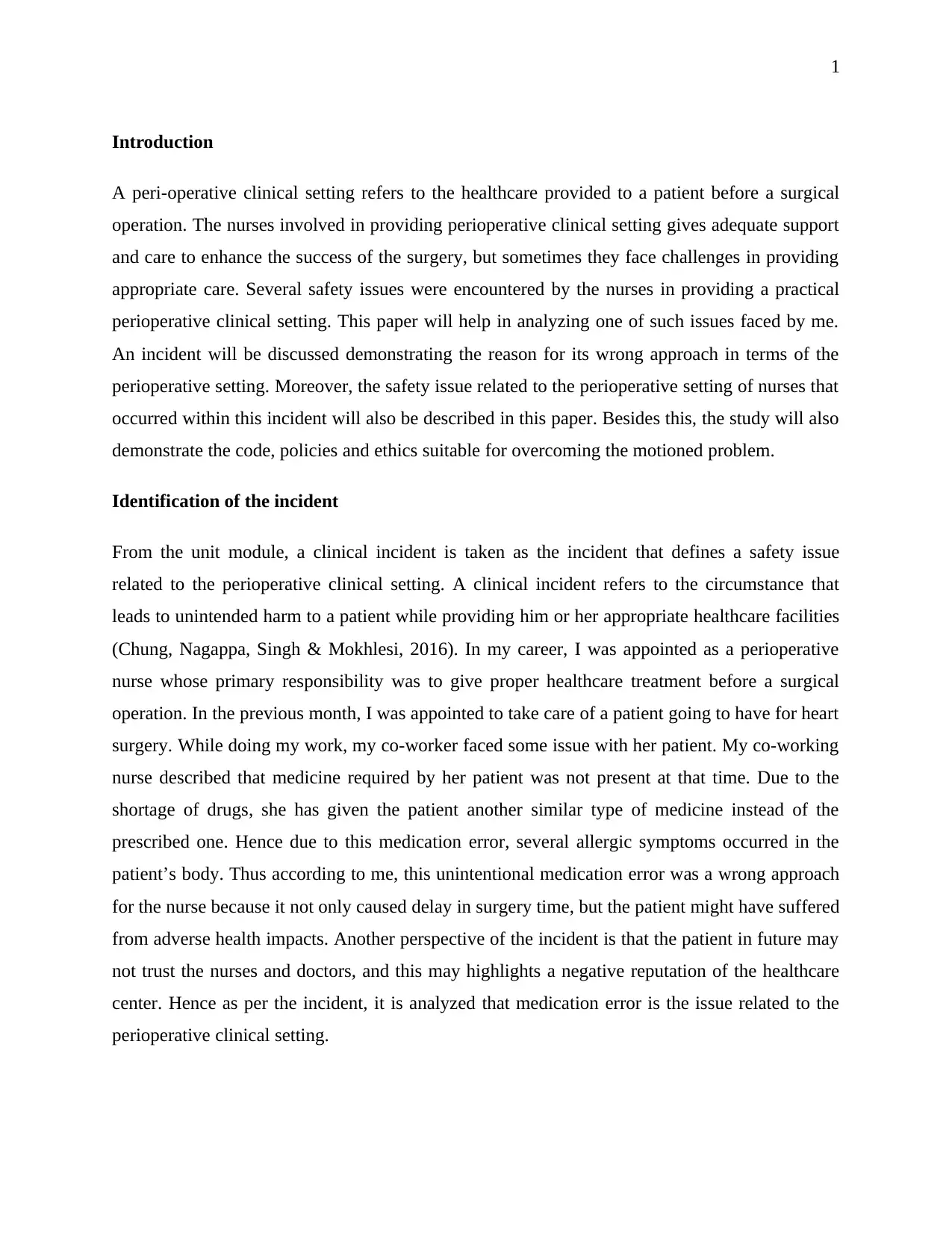
1
Introduction
A peri-operative clinical setting refers to the healthcare provided to a patient before a surgical
operation. The nurses involved in providing perioperative clinical setting gives adequate support
and care to enhance the success of the surgery, but sometimes they face challenges in providing
appropriate care. Several safety issues were encountered by the nurses in providing a practical
perioperative clinical setting. This paper will help in analyzing one of such issues faced by me.
An incident will be discussed demonstrating the reason for its wrong approach in terms of the
perioperative setting. Moreover, the safety issue related to the perioperative setting of nurses that
occurred within this incident will also be described in this paper. Besides this, the study will also
demonstrate the code, policies and ethics suitable for overcoming the motioned problem.
Identification of the incident
From the unit module, a clinical incident is taken as the incident that defines a safety issue
related to the perioperative clinical setting. A clinical incident refers to the circumstance that
leads to unintended harm to a patient while providing him or her appropriate healthcare facilities
(Chung, Nagappa, Singh & Mokhlesi, 2016). In my career, I was appointed as a perioperative
nurse whose primary responsibility was to give proper healthcare treatment before a surgical
operation. In the previous month, I was appointed to take care of a patient going to have for heart
surgery. While doing my work, my co-worker faced some issue with her patient. My co-working
nurse described that medicine required by her patient was not present at that time. Due to the
shortage of drugs, she has given the patient another similar type of medicine instead of the
prescribed one. Hence due to this medication error, several allergic symptoms occurred in the
patient’s body. Thus according to me, this unintentional medication error was a wrong approach
for the nurse because it not only caused delay in surgery time, but the patient might have suffered
from adverse health impacts. Another perspective of the incident is that the patient in future may
not trust the nurses and doctors, and this may highlights a negative reputation of the healthcare
center. Hence as per the incident, it is analyzed that medication error is the issue related to the
perioperative clinical setting.
Introduction
A peri-operative clinical setting refers to the healthcare provided to a patient before a surgical
operation. The nurses involved in providing perioperative clinical setting gives adequate support
and care to enhance the success of the surgery, but sometimes they face challenges in providing
appropriate care. Several safety issues were encountered by the nurses in providing a practical
perioperative clinical setting. This paper will help in analyzing one of such issues faced by me.
An incident will be discussed demonstrating the reason for its wrong approach in terms of the
perioperative setting. Moreover, the safety issue related to the perioperative setting of nurses that
occurred within this incident will also be described in this paper. Besides this, the study will also
demonstrate the code, policies and ethics suitable for overcoming the motioned problem.
Identification of the incident
From the unit module, a clinical incident is taken as the incident that defines a safety issue
related to the perioperative clinical setting. A clinical incident refers to the circumstance that
leads to unintended harm to a patient while providing him or her appropriate healthcare facilities
(Chung, Nagappa, Singh & Mokhlesi, 2016). In my career, I was appointed as a perioperative
nurse whose primary responsibility was to give proper healthcare treatment before a surgical
operation. In the previous month, I was appointed to take care of a patient going to have for heart
surgery. While doing my work, my co-worker faced some issue with her patient. My co-working
nurse described that medicine required by her patient was not present at that time. Due to the
shortage of drugs, she has given the patient another similar type of medicine instead of the
prescribed one. Hence due to this medication error, several allergic symptoms occurred in the
patient’s body. Thus according to me, this unintentional medication error was a wrong approach
for the nurse because it not only caused delay in surgery time, but the patient might have suffered
from adverse health impacts. Another perspective of the incident is that the patient in future may
not trust the nurses and doctors, and this may highlights a negative reputation of the healthcare
center. Hence as per the incident, it is analyzed that medication error is the issue related to the
perioperative clinical setting.
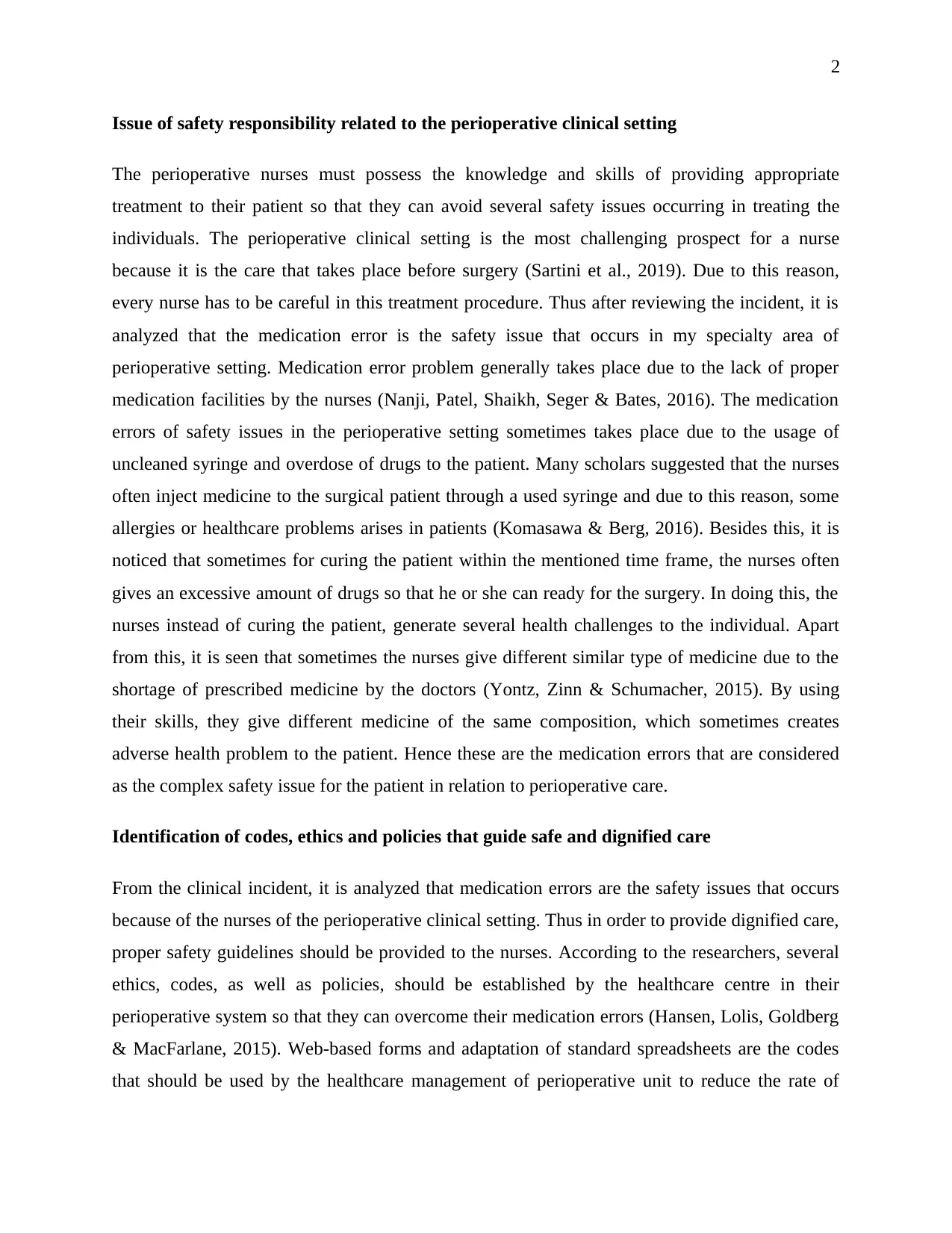
2
Issue of safety responsibility related to the perioperative clinical setting
The perioperative nurses must possess the knowledge and skills of providing appropriate
treatment to their patient so that they can avoid several safety issues occurring in treating the
individuals. The perioperative clinical setting is the most challenging prospect for a nurse
because it is the care that takes place before surgery (Sartini et al., 2019). Due to this reason,
every nurse has to be careful in this treatment procedure. Thus after reviewing the incident, it is
analyzed that the medication error is the safety issue that occurs in my specialty area of
perioperative setting. Medication error problem generally takes place due to the lack of proper
medication facilities by the nurses (Nanji, Patel, Shaikh, Seger & Bates, 2016). The medication
errors of safety issues in the perioperative setting sometimes takes place due to the usage of
uncleaned syringe and overdose of drugs to the patient. Many scholars suggested that the nurses
often inject medicine to the surgical patient through a used syringe and due to this reason, some
allergies or healthcare problems arises in patients (Komasawa & Berg, 2016). Besides this, it is
noticed that sometimes for curing the patient within the mentioned time frame, the nurses often
gives an excessive amount of drugs so that he or she can ready for the surgery. In doing this, the
nurses instead of curing the patient, generate several health challenges to the individual. Apart
from this, it is seen that sometimes the nurses give different similar type of medicine due to the
shortage of prescribed medicine by the doctors (Yontz, Zinn & Schumacher, 2015). By using
their skills, they give different medicine of the same composition, which sometimes creates
adverse health problem to the patient. Hence these are the medication errors that are considered
as the complex safety issue for the patient in relation to perioperative care.
Identification of codes, ethics and policies that guide safe and dignified care
From the clinical incident, it is analyzed that medication errors are the safety issues that occurs
because of the nurses of the perioperative clinical setting. Thus in order to provide dignified care,
proper safety guidelines should be provided to the nurses. According to the researchers, several
ethics, codes, as well as policies, should be established by the healthcare centre in their
perioperative system so that they can overcome their medication errors (Hansen, Lolis, Goldberg
& MacFarlane, 2015). Web-based forms and adaptation of standard spreadsheets are the codes
that should be used by the healthcare management of perioperative unit to reduce the rate of
Issue of safety responsibility related to the perioperative clinical setting
The perioperative nurses must possess the knowledge and skills of providing appropriate
treatment to their patient so that they can avoid several safety issues occurring in treating the
individuals. The perioperative clinical setting is the most challenging prospect for a nurse
because it is the care that takes place before surgery (Sartini et al., 2019). Due to this reason,
every nurse has to be careful in this treatment procedure. Thus after reviewing the incident, it is
analyzed that the medication error is the safety issue that occurs in my specialty area of
perioperative setting. Medication error problem generally takes place due to the lack of proper
medication facilities by the nurses (Nanji, Patel, Shaikh, Seger & Bates, 2016). The medication
errors of safety issues in the perioperative setting sometimes takes place due to the usage of
uncleaned syringe and overdose of drugs to the patient. Many scholars suggested that the nurses
often inject medicine to the surgical patient through a used syringe and due to this reason, some
allergies or healthcare problems arises in patients (Komasawa & Berg, 2016). Besides this, it is
noticed that sometimes for curing the patient within the mentioned time frame, the nurses often
gives an excessive amount of drugs so that he or she can ready for the surgery. In doing this, the
nurses instead of curing the patient, generate several health challenges to the individual. Apart
from this, it is seen that sometimes the nurses give different similar type of medicine due to the
shortage of prescribed medicine by the doctors (Yontz, Zinn & Schumacher, 2015). By using
their skills, they give different medicine of the same composition, which sometimes creates
adverse health problem to the patient. Hence these are the medication errors that are considered
as the complex safety issue for the patient in relation to perioperative care.
Identification of codes, ethics and policies that guide safe and dignified care
From the clinical incident, it is analyzed that medication errors are the safety issues that occurs
because of the nurses of the perioperative clinical setting. Thus in order to provide dignified care,
proper safety guidelines should be provided to the nurses. According to the researchers, several
ethics, codes, as well as policies, should be established by the healthcare centre in their
perioperative system so that they can overcome their medication errors (Hansen, Lolis, Goldberg
& MacFarlane, 2015). Web-based forms and adaptation of standard spreadsheets are the codes
that should be used by the healthcare management of perioperative unit to reduce the rate of
⊘ This is a preview!⊘
Do you want full access?
Subscribe today to unlock all pages.

Trusted by 1+ million students worldwide
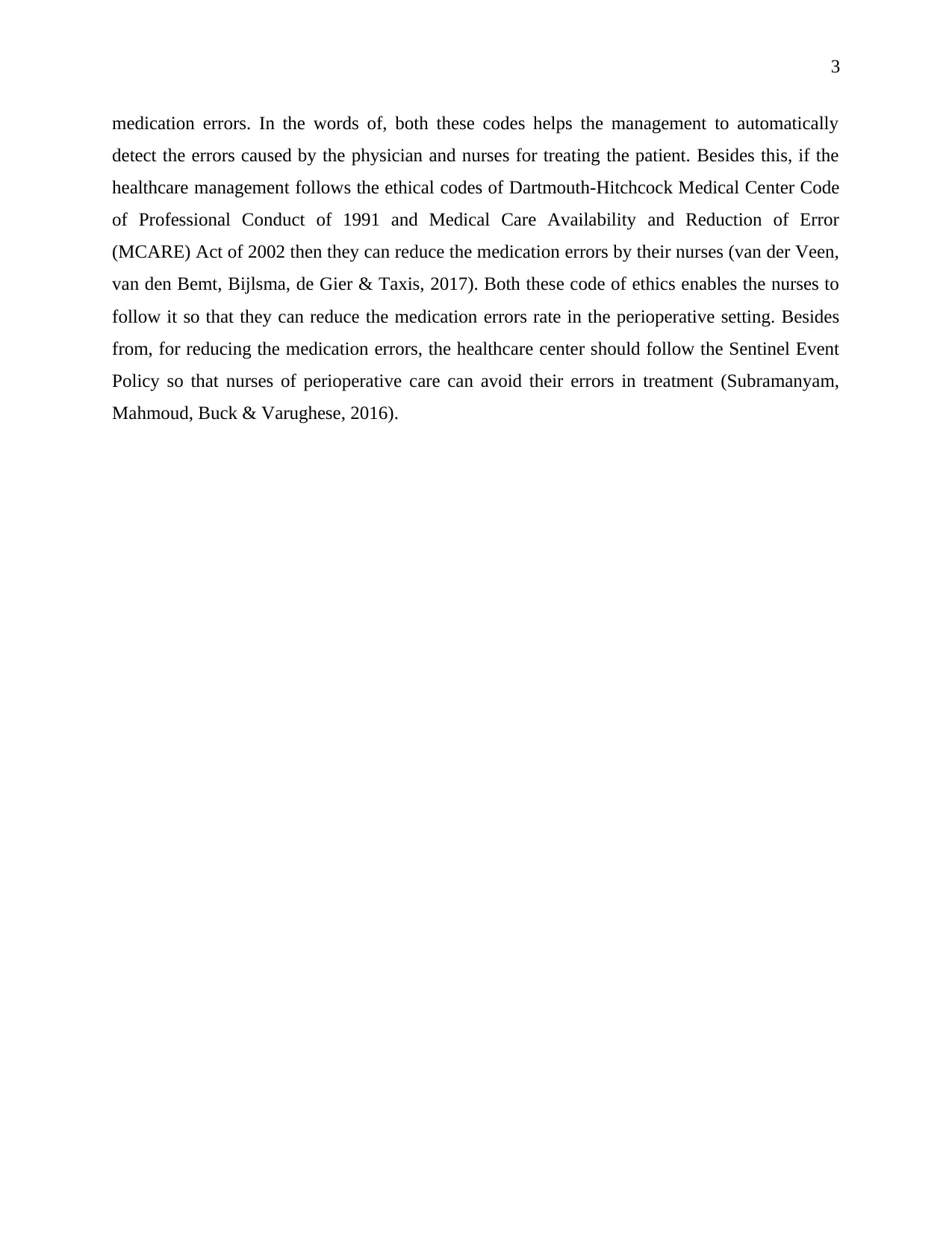
3
medication errors. In the words of, both these codes helps the management to automatically
detect the errors caused by the physician and nurses for treating the patient. Besides this, if the
healthcare management follows the ethical codes of Dartmouth-Hitchcock Medical Center Code
of Professional Conduct of 1991 and Medical Care Availability and Reduction of Error
(MCARE) Act of 2002 then they can reduce the medication errors by their nurses (van der Veen,
van den Bemt, Bijlsma, de Gier & Taxis, 2017). Both these code of ethics enables the nurses to
follow it so that they can reduce the medication errors rate in the perioperative setting. Besides
from, for reducing the medication errors, the healthcare center should follow the Sentinel Event
Policy so that nurses of perioperative care can avoid their errors in treatment (Subramanyam,
Mahmoud, Buck & Varughese, 2016).
medication errors. In the words of, both these codes helps the management to automatically
detect the errors caused by the physician and nurses for treating the patient. Besides this, if the
healthcare management follows the ethical codes of Dartmouth-Hitchcock Medical Center Code
of Professional Conduct of 1991 and Medical Care Availability and Reduction of Error
(MCARE) Act of 2002 then they can reduce the medication errors by their nurses (van der Veen,
van den Bemt, Bijlsma, de Gier & Taxis, 2017). Both these code of ethics enables the nurses to
follow it so that they can reduce the medication errors rate in the perioperative setting. Besides
from, for reducing the medication errors, the healthcare center should follow the Sentinel Event
Policy so that nurses of perioperative care can avoid their errors in treatment (Subramanyam,
Mahmoud, Buck & Varughese, 2016).
Paraphrase This Document
Need a fresh take? Get an instant paraphrase of this document with our AI Paraphraser
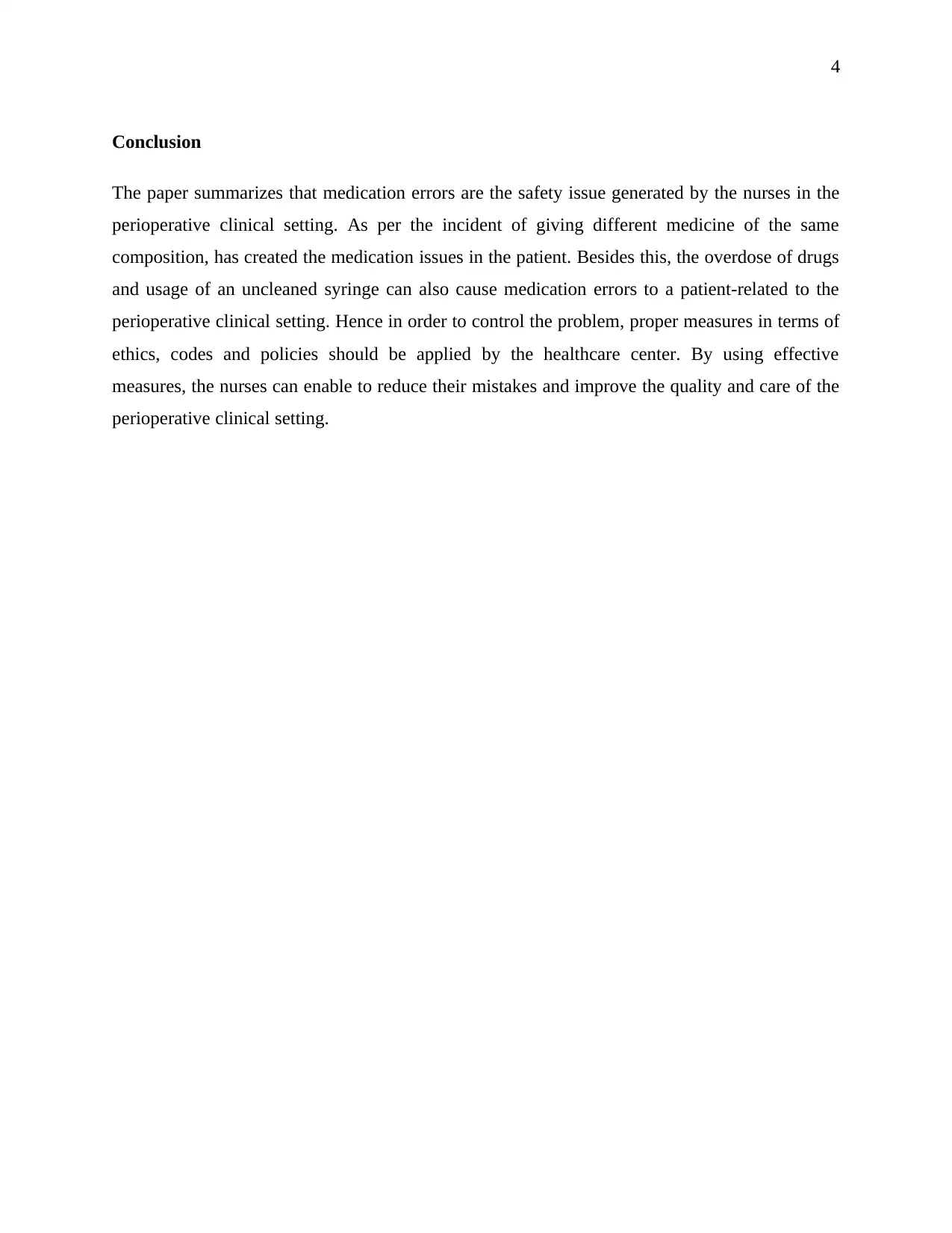
4
Conclusion
The paper summarizes that medication errors are the safety issue generated by the nurses in the
perioperative clinical setting. As per the incident of giving different medicine of the same
composition, has created the medication issues in the patient. Besides this, the overdose of drugs
and usage of an uncleaned syringe can also cause medication errors to a patient-related to the
perioperative clinical setting. Hence in order to control the problem, proper measures in terms of
ethics, codes and policies should be applied by the healthcare center. By using effective
measures, the nurses can enable to reduce their mistakes and improve the quality and care of the
perioperative clinical setting.
Conclusion
The paper summarizes that medication errors are the safety issue generated by the nurses in the
perioperative clinical setting. As per the incident of giving different medicine of the same
composition, has created the medication issues in the patient. Besides this, the overdose of drugs
and usage of an uncleaned syringe can also cause medication errors to a patient-related to the
perioperative clinical setting. Hence in order to control the problem, proper measures in terms of
ethics, codes and policies should be applied by the healthcare center. By using effective
measures, the nurses can enable to reduce their mistakes and improve the quality and care of the
perioperative clinical setting.
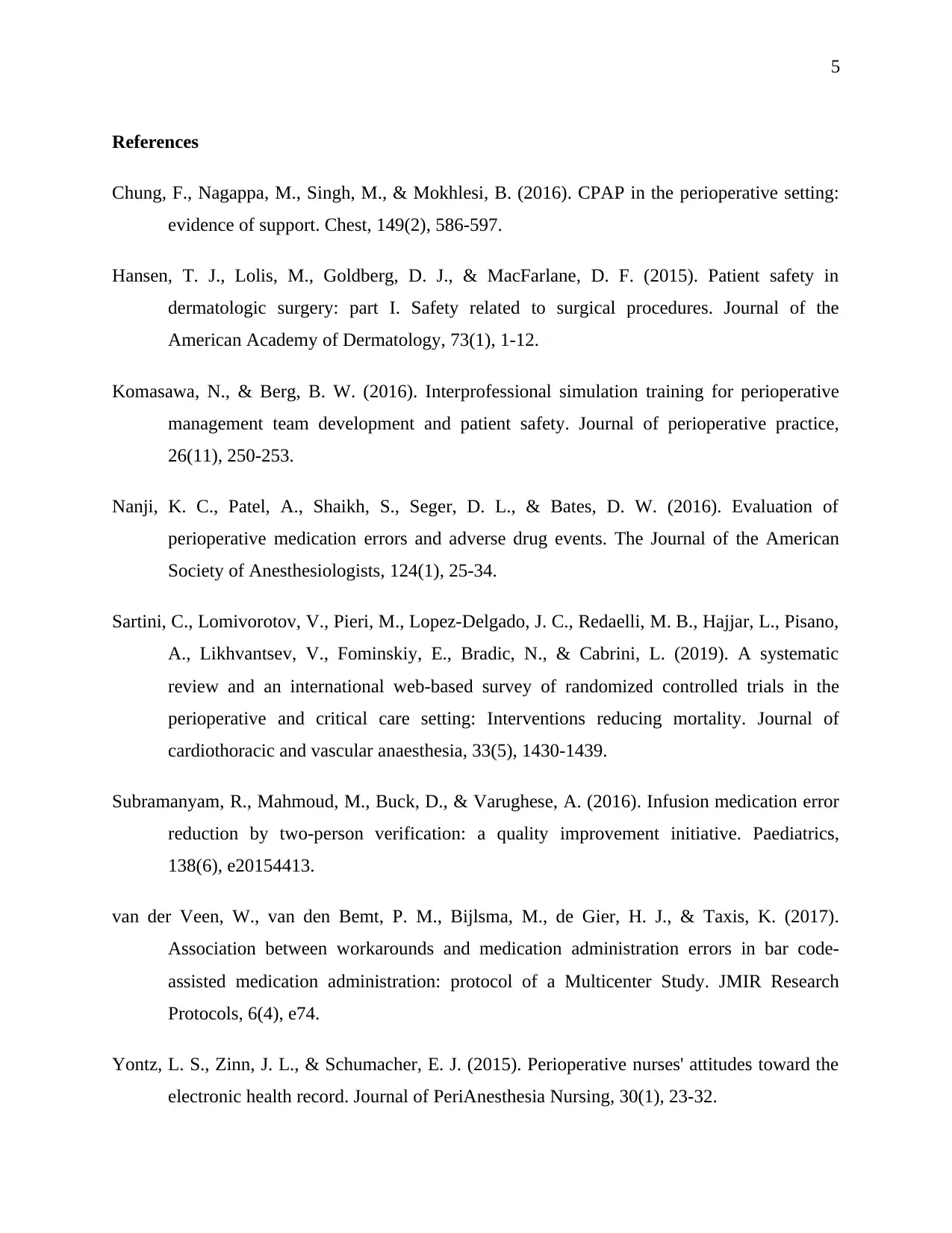
5
References
Chung, F., Nagappa, M., Singh, M., & Mokhlesi, B. (2016). CPAP in the perioperative setting:
evidence of support. Chest, 149(2), 586-597.
Hansen, T. J., Lolis, M., Goldberg, D. J., & MacFarlane, D. F. (2015). Patient safety in
dermatologic surgery: part I. Safety related to surgical procedures. Journal of the
American Academy of Dermatology, 73(1), 1-12.
Komasawa, N., & Berg, B. W. (2016). Interprofessional simulation training for perioperative
management team development and patient safety. Journal of perioperative practice,
26(11), 250-253.
Nanji, K. C., Patel, A., Shaikh, S., Seger, D. L., & Bates, D. W. (2016). Evaluation of
perioperative medication errors and adverse drug events. The Journal of the American
Society of Anesthesiologists, 124(1), 25-34.
Sartini, C., Lomivorotov, V., Pieri, M., Lopez-Delgado, J. C., Redaelli, M. B., Hajjar, L., Pisano,
A., Likhvantsev, V., Fominskiy, E., Bradic, N., & Cabrini, L. (2019). A systematic
review and an international web-based survey of randomized controlled trials in the
perioperative and critical care setting: Interventions reducing mortality. Journal of
cardiothoracic and vascular anaesthesia, 33(5), 1430-1439.
Subramanyam, R., Mahmoud, M., Buck, D., & Varughese, A. (2016). Infusion medication error
reduction by two-person verification: a quality improvement initiative. Paediatrics,
138(6), e20154413.
van der Veen, W., van den Bemt, P. M., Bijlsma, M., de Gier, H. J., & Taxis, K. (2017).
Association between workarounds and medication administration errors in bar code-
assisted medication administration: protocol of a Multicenter Study. JMIR Research
Protocols, 6(4), e74.
Yontz, L. S., Zinn, J. L., & Schumacher, E. J. (2015). Perioperative nurses' attitudes toward the
electronic health record. Journal of PeriAnesthesia Nursing, 30(1), 23-32.
References
Chung, F., Nagappa, M., Singh, M., & Mokhlesi, B. (2016). CPAP in the perioperative setting:
evidence of support. Chest, 149(2), 586-597.
Hansen, T. J., Lolis, M., Goldberg, D. J., & MacFarlane, D. F. (2015). Patient safety in
dermatologic surgery: part I. Safety related to surgical procedures. Journal of the
American Academy of Dermatology, 73(1), 1-12.
Komasawa, N., & Berg, B. W. (2016). Interprofessional simulation training for perioperative
management team development and patient safety. Journal of perioperative practice,
26(11), 250-253.
Nanji, K. C., Patel, A., Shaikh, S., Seger, D. L., & Bates, D. W. (2016). Evaluation of
perioperative medication errors and adverse drug events. The Journal of the American
Society of Anesthesiologists, 124(1), 25-34.
Sartini, C., Lomivorotov, V., Pieri, M., Lopez-Delgado, J. C., Redaelli, M. B., Hajjar, L., Pisano,
A., Likhvantsev, V., Fominskiy, E., Bradic, N., & Cabrini, L. (2019). A systematic
review and an international web-based survey of randomized controlled trials in the
perioperative and critical care setting: Interventions reducing mortality. Journal of
cardiothoracic and vascular anaesthesia, 33(5), 1430-1439.
Subramanyam, R., Mahmoud, M., Buck, D., & Varughese, A. (2016). Infusion medication error
reduction by two-person verification: a quality improvement initiative. Paediatrics,
138(6), e20154413.
van der Veen, W., van den Bemt, P. M., Bijlsma, M., de Gier, H. J., & Taxis, K. (2017).
Association between workarounds and medication administration errors in bar code-
assisted medication administration: protocol of a Multicenter Study. JMIR Research
Protocols, 6(4), e74.
Yontz, L. S., Zinn, J. L., & Schumacher, E. J. (2015). Perioperative nurses' attitudes toward the
electronic health record. Journal of PeriAnesthesia Nursing, 30(1), 23-32.
⊘ This is a preview!⊘
Do you want full access?
Subscribe today to unlock all pages.

Trusted by 1+ million students worldwide
1 out of 6
Related Documents
Your All-in-One AI-Powered Toolkit for Academic Success.
+13062052269
info@desklib.com
Available 24*7 on WhatsApp / Email
![[object Object]](/_next/static/media/star-bottom.7253800d.svg)
Unlock your academic potential
Copyright © 2020–2025 A2Z Services. All Rights Reserved. Developed and managed by ZUCOL.





